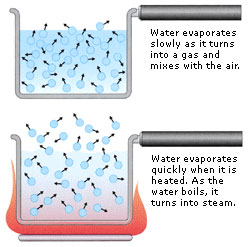Education: Activities & Documents
Evaporation Investigation
Evaporation is the process by which water changes from a liquid to a gas or vapor. Evaporation is the primary pathway that water moves from the liquid state back into the water cycle as atmospheric water vapor. Studies have shown that the oceans, seas, lakes, and rivers provide nearly 90 percent of the moisture in the atmosphere via evaporation, with the remaining 10 percent being contributed by plant transpiration.Evaporation from the oceans is the primary mechanism supporting the surface-to-atmosphere portion of the water cycle. After all, the large surface area of the oceans (over 70 percent of the Earth's surface is covered by the oceans) provides the opportunity for large-scale evaporation to occur. On a global scale, the amount of water evaporating is about the same as the amount of water delivered to the Earth as precipitation. This does vary geographically, though. Evaporation is more prevalent over the oceans than precipitation, while over the land, precipitation routinely exceeds evaporation. Most of the water that evaporates from the oceans falls back into the oceans as precipitation. Only about 10% of the water evaporated from the oceans is transported over land and falls as precipitation. Once evaporated, a water molecule spends about 10 days in the air. The process of evaporation is so great that without precipitation, run-off, and groundwater discharge from aquifers, oceans would become nearly empty.
Less evaporation takes place during periods of calm winds than during windy times. When the air is calm, evaporated water tends to stay close to the water body. When the winds are present, the more moist air close to the water body is moved away and replaced with drier air which favors additional evaporation.
- Big Idea. Water can "disappear" or evaporate into the air.
- Grade Level. Elementary.
- Time Activity 1. One 20 min. period, with follow up 10 min observation sessions, 30 min. wrap up.
- Time Activity 2. Two 30 minute periods.
- Content Standard. NSES Physical Science, properties of objects and materials.
- Ocean Literacy Principle. (1f) The ocean is an integral part of the water cycle and is connected to all of the earth's water reservoirs via evaporation and precipitation.
Materials
Activity 1 - containers with lids (coffee cans work well), water, wooden stirring sticks (paint stirrers work well), markers, colored sticky dots, measuring cups; optional materials include, construction paper, glue. Activity 2 - salt, warm water (aids dissolving of the salt), paper, paint brushes, food coloring, measuring cups, containers (plastic cups work well and can be reused), spoons for mixing.evap_invest.pdf (1.3 MB)

